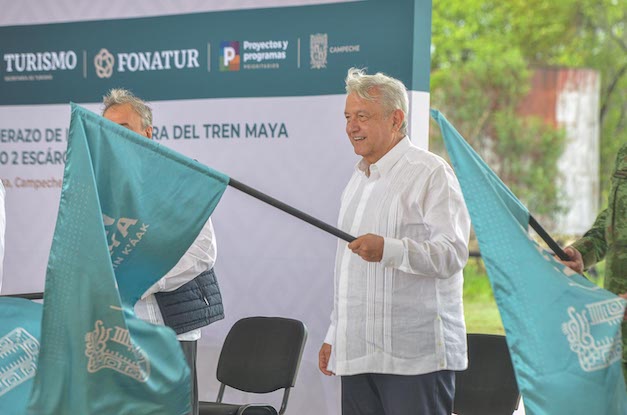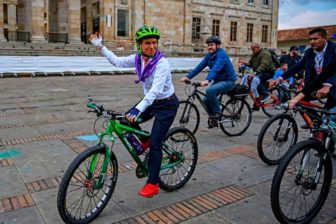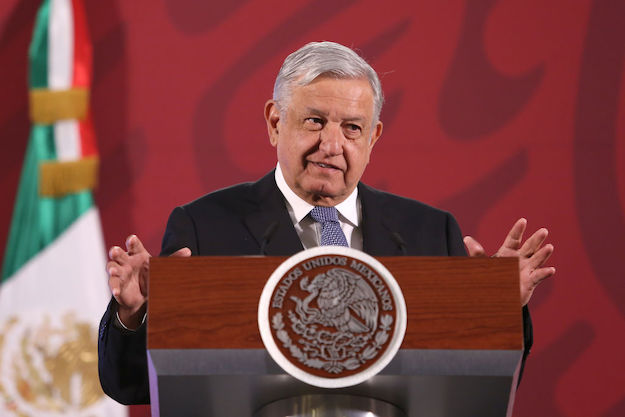MEXICO CITY – Andrés Manuel López Obrador doesn’t intend to let the coronavirus upend his “fourth transformation” of Mexico. On a whistle-stop tour of southern states this week, the president is touting progress on a development agenda that has changed strikingly little since the pandemic began: a tourist rail network on the Yucatan peninsula broke ground on June 1, with a separate cross-isthmus train line and investment corridor also in the works. Construction on an $8-billion oil refinery and a new airport outside Mexico City never stopped.
López Obrador’s big-ticket infrastructure projects were controversial before the pandemic, amid unresolved questions about financial viability and environmental impact. Now, with Mexico’s daily coronavirus count yet to plateau and a death toll over 10,000, some see the president’s commitment to his campaign agenda as a stubborn misuse of limited resources.
“It’s investment that could be directed to areas of much more urgent need,” Macario Schettino, a Mexican political and economic analyst, told AQ.
López Obrador says the projects, which together the administration expects to cost around $18 billion, will help “accelerate” the post-pandemic recovery; the administration claims they will account for 10% of the 2 million jobs it has pledged to create this year. The Maya Train, which will shuttle passengers to and from Cancún, Bacalar and other tourist hot spots, is projected to provide 80,000 jobs on its own.
Observers are skeptical. Mexico’s economy has never seen even 1 million new jobs created in the nine months that López Obrador has given himself to double that. The government’s expected employment bump comes mostly from projects that were already on the books or expansions of unproven social programs. A youth apprenticeship scheme that enrolled close to a million young people in 2019 – and which the government says will be the biggest driver of new employment – led directly to only 20,000 permanent jobs in that time.
“The goal is far from what they’ll be able to achieve,” Edmundo Gamas, director of the Mexican Institute of Infrastructure Development (IMEXDI), told AQ. “On top of that, the quality of the jobs they’re talking about creating doesn’t compare with the jobs being lost. Most of these would be temporary, with very low salaries and without benefits.”
Meanwhile, half a million Mexicans lost their jobs in April. Rather than a boon for the country’s economy, observers fear the infrastructure projects will become a herd of white elephants. A report from Mexican think tank IMCO, written before the impact of the pandemic became clear, suggested that the refinery had a less than 2% chance of being worth its cost. Many analysts also expect the $8-billion price tag to increase, after the initial concession yielded no private sector bids that fit the president’s time and cost requirements. Government agencies and state oil firm Pemex were eventually tasked to oversee construction.
Similar questions hover over the Maya Train project. Mexico’s national human rights commission has called for a temporary halt to the project over coronavirus concerns in nearby indigenous communities. Environmental groups say they have yet to see a satisfactory projection of the train’s impact on protected lands.
López Obrador is nonetheless charging ahead. Speaking at a groundbreaking ceremony this week, he said that the new line would follow the same path as a now-defunct stretch of track built in the middle of the last century, minimizing environmental costs. He also said that his personal relationships with the heads of the companies involved in the train’s construction would help ensure that the project comes in on time and budget.
According to Mariana Campos, who directs the public spending program at México Evalúa, Mexico lacks the institutional strength and planning mechanisms to meaningfully control costs on major infrastructure projects. In contrast to the Mexico City airport, budget execution for the train and refinery projects so far has been below expectations – a possible indicator of complexities that could delay construction progress and increase costs.
“Even well-planned megaprojects are hard to control,” Campos told AQ. “If it’s hard for Germany, it’s basically impossible for Mexico.”
These concerns have led some to suggest that López Obrador should divert funds intended for his infrastructure plan to deal with the economic effects of the virus. López Obrador’s COVID-19 stimulus plans total less than 1% of GDP in new spending by some estimates, far below most of the rest of the region. Reticent to take on new debt, the president is instead relying on a rainy day fund and spending cuts to weather the storm.
There is a lot riding on López Obrador’s more optimistic view of recovery, especially in Mexico’s southeast, which trails the rest of the country in GDP and most social indicators, and where much of the president’s development plans are concentrated.
While the south needs more attention and investment from the government, the concentration of resources could limit the effects of public spending on a post-COVID recovery. As it is, around 70% of planned federal investment is divided between Mexico City and two southern states, Campos said.
“Instead of a few big projects focused in just a few states, reassigning investment to smaller projects in each state in the country would allow for more effective and wider spread recovery,” Campos said.
López Obrador’s emphasis on the southeast is driven in part by his own experience growing up in the region at a time when oil was viewed as synonymous with prosperity. The president also cited the significance of passenger trains in connecting the region to the rest of the country during the Mexican Revolution, on railways that were canceled “in the blink of an eye at the beginning of the neoliberal period.”
Some critics, however, believe the president is drawing the wrong lessons from Mexico’s past. “It’s a textbook view of a history that never really existed,” said Schettino. “The southern states haven’t developed because they’ve never been brought into the modern economy. These plans aren’t going to change that.”








